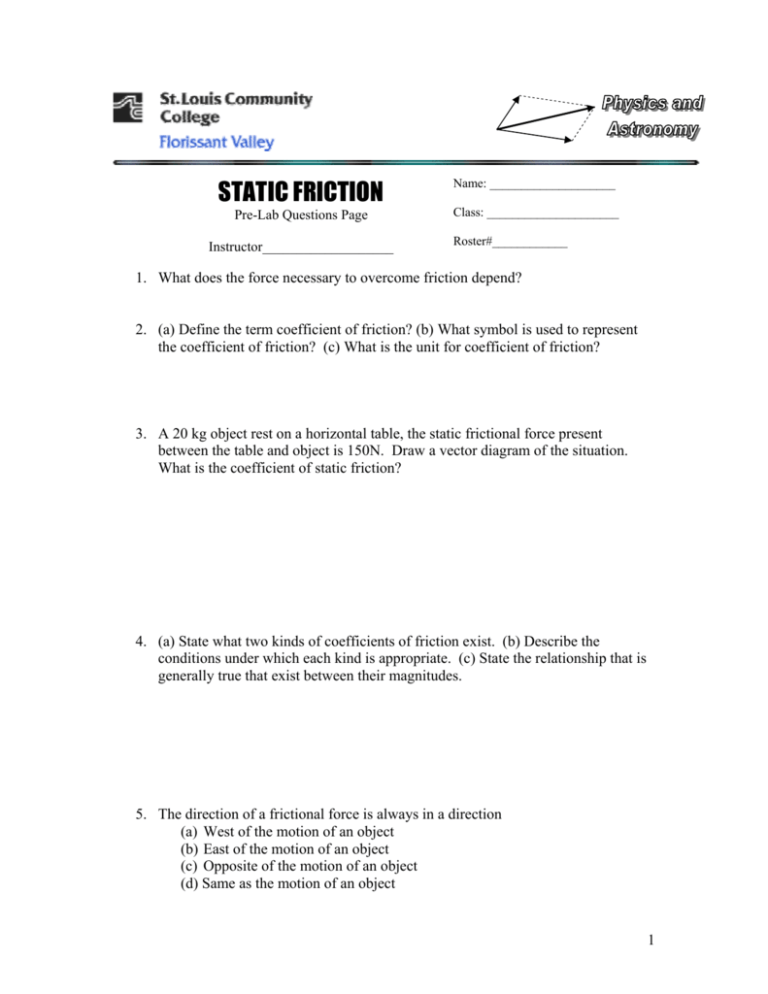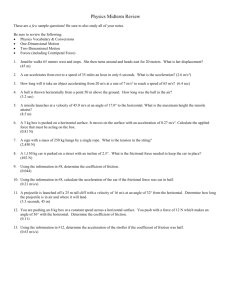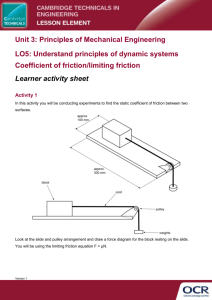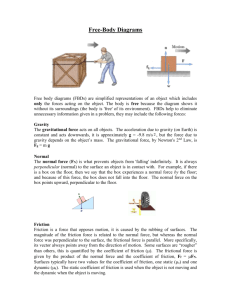static frictional forces
advertisement

STATIC FRICTION Name: ____________________ Pre-Lab Questions Page Class: _____________________ Instructor___________________ Roster#____________ 1. What does the force necessary to overcome friction depend? 2. (a) Define the term coefficient of friction? (b) What symbol is used to represent the coefficient of friction? (c) What is the unit for coefficient of friction? 3. A 20 kg object rest on a horizontal table, the static frictional force present between the table and object is 150N. Draw a vector diagram of the situation. What is the coefficient of static friction? 4. (a) State what two kinds of coefficients of friction exist. (b) Describe the conditions under which each kind is appropriate. (c) State the relationship that is generally true that exist between their magnitudes. 5. The direction of a frictional force is always in a direction (a) West of the motion of an object (b) East of the motion of an object (c) Opposite of the motion of an object (d) Same as the motion of an object 1 STATIC FRICTIONAL FORCES OBJECTIVE: Study the frictional force between a wood block and a wood board. Experimentally determine the coefficient of static friction. APPARATUS: wood friction board mass hangers ball-bearing pulley various slotted masses wood block scissors string scale paper towels Inclinometer(angle finder) INTRODUCTION: Friction is the resisting force encountered when one surface slides over another; this force acts along the tangent to the surfaces in contact. The force necessary to overcome friction depends on what the object is made of, the roughness or smoothness of the surface, and on the normal force, and the actual area of contact but not on the apparent area of contact. It is found experimentally that the force of friction is directly proportional to the normal force. The constant of proportionality is called the coefficient of friction, represented by the following symbol µ. When the contact surfaces are actually in motion, the force of friction is given by fk = µk FN (eq. 1) where fk is the kinetic frictional force, µk is the coefficient of kinetic friction and FN is the normal force. In cases where there is no motion, the object remains stationary, you are dealing with static frictional forces, fs. We rewrite equation 1 to speak to this case: fs = µs FN (eq. 2) where µs = coefficient of static friction. When a force is applied to the object, the static frictional force must be overcome to start the object moving. If this does not happen then the object remains in equilibrium, or stationary, and the static frictional force adjust itself to balance the applied force. There is a threshold value of the frictional force beyond which larger values will cause the body to break away and slide. We conclude that in the static case the frictional force automatically balances the applied force to keep the body at rest up to a maximum value. The maximum static frictional force, fsmax, is always greater than the kinetic frictional force. Simple logic and experience tells us that it is easier to keep an object in motion, than it is to start the object moving, therefore 2 fsmax = µs FN > fk = µk FN where fsmax = maximum static friction that exist. One way to investigate the case of static friction is to observe the so-called limiting angle of repose, Θmax, defined as the maximum angle to which an inclined plane may be raised before a block placed on the plane just starts to slide. The maximum coefficient of friction is related to the limiting angle of repose by the following equation: µs = tan Θmax . PROCEDURE_A: The Coefficient of Static Friction 1. Weigh the wood block and record the weight in newtons. Recall: w = mg 2. Place the board in a horizontal position on the laboratory table with its pulley projecting beyond the table’s edge. Be sure that the surfaces are clean, dry and free of any dust or grit. Use a paper towel to wipe the surface. After this has been done do not touch the surfaces with your hand. 3. Place the block on top of the board, make sure the greatest surface area of the block is touching the board. Tie the string to the hook in the center of the block and hang it over the pulley connecting it to a weight hanger. The string needs to be just long enough so the weight hanger hangs just below the pulley. See figure 1 figure 1 4. Place some (slotted masses) on the hanger and slowly increase the load until it is just sufficient to start the block sliding on its own. Make sure to add the weights to the hanger slowly and do not drop the weights onto the hanger but slowly and gently place them onto the hanger. A technique that can be used is to place your finger under the hanger, for support, while placing the weight onto the hanger. Once the weight has been placed unto the hanger remove your finger slowly. 3 5. The static frictional force is equal to the weight needed to get the block moving on its own. Do not forget to include the mass of the hanger. See figure 2 figure 2 6. Repeat the previous steps, but add (slotted masses) to the block, increasing the normal force. Add 200, 400, 600, and 800g successively on top of the wood block. Record the information in Data Table 1. 7. Graph the results found in data table. The normal force, FN, is plotted on the horizontal axis and the static frictional force, fs, is plotted on the vertical. 8. Print out a copy of the graph, include the data chart. PROCEDURE B: The Coefficient of Static Friction on Edge. 1. Repeat procedure A but this time turn the block on its side, the narrow edge. Place your results in Data Table 2. Make sure to graph your results. PROCEDURE C: The limiting Angle of Repose. 1. Set up the board as an inclined plane. Place the wood block toward the top of the board with the largest surface in contact, and then place the angle finder on the opposite end of the board. Slowly raise the board (plane) until the block just breaks away and starts to slide down and determine this angle from the angle finder. Be very careful to raise the board slowly and smoothly so as to get an accurate value of the angle with the horizontal at which the block just breaks away. This is the limiting angle of repose Θmax. Record your results in Data Table 3. 2. Repeat procedure 1 for a total of 3 trials. 4 Mass of wood block: ____________ Weight of wood block: ____________ DATA TABLE 1 Static Friction Position of Block Flat Flat Flat Flat Flat Mass placed on Block 0g 200 g 400 g 600 g 800 g Normal Force (N) Static Frictional Force (N) Coefficient of Static friction, µs ,from graph _____________ (from procedure A) DATA TABLE 2 Position of Block On side On Side On Side On Side On Side Static Friction (for block on its side) Mass placed on Normal Force Block (N) 0g 200 g 400 g 600 g 800 g Static Frictional Force (N) Coefficient of Static friction, µs ,from graph _____________ (from procedure B) 5 DATA TABLE 3 Angle of Repose Θmax Trial 1 Deviation µs Θmax Trial 2 Deviation µs Θmax Trial 3 Deviation µs Average coefficient of static friction, µs __________________(from procedure C) Note: The deviation is simply the average µs minus the individual values from trial 1, 2 and 3. CALCULATIONS/DATA ANALYSIS: 1. Compare the values of the coefficient of static friction found in Procedure A & B, using the %difference equation. Recall: %difference = ⏐E1 – E2⏐÷ ⏐E1 + E2⏐x 200 2. Compare the average coefficient of static friction value using the limiting angle of repose with each value from procedure A and then procedure B. Using the %difference equation. PRACTICE QUESTIONS: (*Your answers should be in sentence form.) 1. *How does the slope of graph 1 & 2, from Procedures A & B, relate to the coefficient of static friction? 2. *Should graph 1 & 2 go through the origin? Explain your answer. 3. *Do you think a straight line would be the best fit to the data plots of graph 1 & 2? 6 4. Write a linear equation to represent graph 1, that is in the form of “y = mx+b”. 5. Write a linear equation to represent graph 2, that is in the form of “y = mx+b.” 6. *According to graph 1, if the normal force is doubled what happens to the static frictional force? 7. *(a) How does the coefficient of friction depend upon the normal force between the surfaces in contact? (b) How does it depend upon the area of the surfaces in contact? 7






